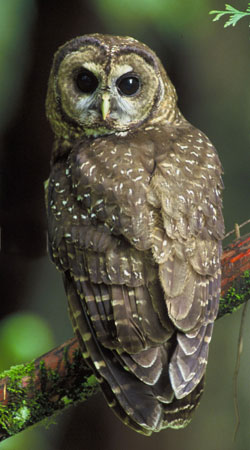
Home | About Us | Projects | Maps | Facts

Home | About Us | Projects | Maps | Facts
|
Spotted Owl (Strix occidentalis)
Description:
The Spotted owl is a medium-sized, dark brown owl with a barred tail, white spots on the head and breast, and dark brown eyes surrounded by prominent facial disks. Males and females have similar plumage, but females typically weigh 10 to 20 percent more than males.
People often mistake the Barred Owl for a Spotted Owl. See if you can find the differences between the two species.
Calls:
The call is a series of four spaced notes with the two middle ones closest together, "hup, hoo-hoo, hooo." Habitat: Spotted owls live in mature coniferous forests with dense canopy cover at low and moderate elevations. The fragmentation of conifer forests has lead to increased occupation by Great Horned Owls and, in the past 20-30 years, the invasion of Barred Owls. Click the range map to learn more about the distribution of Spotted Owls in California. Diet: The Spotted Owl's diet consists of small mammals like flying squirrels, wood rats, mice, voles and also some birds, reptiles, amphibians, and insects. This owl hunts mainly at night by swooping down from a higher perch. 
Nesting: Nests in tree cavities, broken-topped trees, and platforms, such as old raptor or squirrel nests. Does not build its own nest. Spotted owls do not typically reach sexual maturity until after 2 years of age and when they pair, they are monogamous. Adult females lay an average of 2 eggs per clutch with a range of 1 to 4 eggs. The eggs are incubated for 30 days. The chicks start moving out of the nest at 5 weeks and learn to fly at 6 weeks of age. Spotted owl pairs do not typically nest every year, nor are nesting pairs successful every year. Behavior: Spotted owls are mostly nocturnal, but they may forage opportunistically during the day. Threats: The primary cause of decline in all subspecies of spotted owls is the loss of the old-growth forests where they live. Because of its preference for old-growth forests, it is heavily affected by clear-cut logging. The northern form is considered Endangered in Canada and Threatened in the United States. Natural predators include Northern Goshawks, Great Horned Owls and probably other large raptors including Cooper's and Red-tailed Hawks. Fishers prey upon eggs and young in the nest. Did you know?
Animal silhouettes available to purchase » Photos: top photo by NGAP; lower photo by Hollingsworth |